This is the first entry in a new series I'm calling "Independent Study in World Cinema," in which this self-educated film nerd attempts to fill in some fairly serious gaps in his self-education. For a full explanation of this self-imposed syllabus, read on.
I doubt this will come as much of a shock to anyone who has been reading my reviews, but I do not actually have a graduate degree in film studies…or an undergraduate degree in film studies. In fact, if you want to be strictly accurate about it, I don't have formal training in film studies at all. What I have is a degree in literature and writing, which I acquired at a university that did not—at the time—even have a film studies department. Much of what I learned in my study of literature is applicable to film, of course, but whatever else I know and understand about movies I picked up by watching a truly ridiculous number of movies throughout my life and—once in a while, at least—thinking about them, and reading about them. I began this blog a year-and-a-half ago, in part, because I decided I wanted to think about movies more, and understand them better, and because writing about things is how I do that.
My point is that—while I feel fairly fluent in the language and history of cinema in many ways—there are some pretty serious gaps in my education. And I've been realizing lately that a large number of these gaps can be grouped under one basic umbrella failing: I simply haven't seen enough movies that weren't made in English. For whatever reason—and among the explanations we can certainly include laziness, cultural bias, and the fact that I spent most of my life reliant upon the selections at a series of fairly shitty video stores across the nation—I just haven't seen that many foreign films. There are some absolute giants in the medium—the Godards and Truffauts and Bressons, the Fellinis and Kurosawas and Bergmans—with whose work I am familiar only in passing, or (in extreme cases) by reputation.
Yes, it costs me more than you will ever know to admit that. But what the hell: I'm coming out of the closet.
So this series is my attempt to rectify that shameful situation. I've drawn up a list of about 40 films from around the world, beginning here in 1920 and ending—or so I plan—somewhere around Kieślowski's Three Colors trilogy in 1994. I do not kid myself that this list is comprehensive: I don't expect to get a firm grasp of even a single director—let alone the entire history of film—and I haven't really taken much effort to ensure that every country, language, movement, or era is well-represented. Instead, I've just made a list of works that everyone seems to agree represent tremendous achievements in film history, and which I myself have never seen. (My list is heavy on the French, as you'd expect, with the films of Germany, Italy, Japan, and a certain gentleman from Sweden also figuring prominently.)
What am I hoping to get out of this? For one thing—and this is why I'm doing them chronologically—I'm hoping to get a slightly better grasp of film history: to see how Director A influenced Director B, and how Director C said "Screw Directors A & B, I've got some better ideas." I'm hoping to acquire at least a shallow understanding of the historical context and cultural importance of these films, and to better understand what people mean when they reference things like "Italian neorealism" or "the French New Wave." I'm hoping to remove my own cultural blinders and experience the contributions to the history of film that emerged from other countries and traditions. And I'm hoping to be able to confidently refer to a film's multiple points-of-view structure as being like Rashomon, without ever again worrying that someone is going to call my bluff and force me to admit that I've never actually seen Rashomon.
Mostly—and I can't emphasize this enough—I'm just hoping to watch some great movies, discuss them with people who have seen them, and maybe help introduce them to people who haven't.
I fully expect this to be the longest, most labor-intensive, and least-read series of columns I ever write, but I'm okay with that: hopefully a few of these posts will be interesting to someone besides me. (If you'd like to play along, I'm going to announce the next couple of films I'm planning to watch at the end of each post.)
We begin this week with an influential masterpiece of German Expressionism, Robert Weine's 1920 horror film The Cabinet of Dr. Caligari (Das Cabinet des Dr. Caligari). Like many of the great silent films of the era, Caligari is in the public domain, and available to watch for free (in versions of varying quality) on YouTube, Netflix, archive.org, and other sources. So, if you haven't seen it, go watch it: I'll wait.
As I've said, I'm not a film scholar, and I'm not going to pretend for a moment that I have a comprehensive grasp of German Expressionism. (Let me be absolutely clear: I don't.) However, a few words of overly simplistic context are probably in order. Expressionism emerged at the turn of the 20th century, a time of great societal change and a perfect storm of challenges—in philosophy, psychology, politics, socio-economics, linguistics, and in the arts—to the individual's understanding of reality and his place within it. Expressionism had its roots in the 19th century—in philosophers like Nietzsche and Marx, and in artists like Van Gogh and Munch—and flourished in the early 20th century.
And then, of course, the movement was strongly and darkly influenced by the unimaginable horrors of the First World War (1914-1919), which shattered empires and dynasties, redrew the map of Europe, and turned the dehumanizing tools of the Industrial Revolution into an efficient way to kill some 16 million people. In the years after the war, Expressionism took on a more political air, becoming a means of exploring both personal alienation and the need for political and cultural revolution. In the words of scholar J.W. Syed, "Expressionism, like Romanticism, was a voice of protest against the whole materialistic and mechanical trend of modern technological and industrial civilization which reduces man to a 'robot', alienates him from his own essential nature and makes him a prey to purposeless, tedious and meaningless existence…"
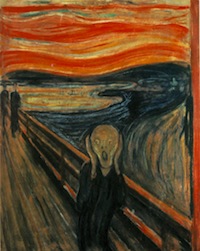 The Expressionists moved away from strict realism and external representation to prioritize the experiences of the artist. Where the Impressionists had tried to translate the external world through the artist's perceptions, the Expressionists sought to make the inner turmoil of the artist external: they prioritized emotion over intellect, subjective reality over objective, and symbolism over literalism.
The Expressionists moved away from strict realism and external representation to prioritize the experiences of the artist. Where the Impressionists had tried to translate the external world through the artist's perceptions, the Expressionists sought to make the inner turmoil of the artist external: they prioritized emotion over intellect, subjective reality over objective, and symbolism over literalism.
What we call "German Expressionism" flourished in the era of the Weimar Republic, the government in place in Germany between the end of the First World War in 1919 and the rise of the Third Reich in 1933. I've even less of a German historian than I am a film historian, but it was, from all reports, not a happy time: the revolutionary left and the radical right were at war with each other, and both were at war with the government, while the entire country—attempting to recover in every way from the horrors of the War to End All Wars—was suffering from skyrocketing inflation and widespread unemployment.
Weimar Germany was, however, a ripe environment for artistic expression, due to a fertile combination of communal trauma, passion for change, and creative liberty. The Weimar government had removed many of the previous administration's censorship laws and restrictions, and so a period of social, sexual, and artistic freedom emerged. The new art form of cinema was under more severe restrictions than other media—films were still produced under the banner of a state-run film studio, Ufa—but this system produced incredible, innovative early works from directors like F. W. Murnau (Nosferatu), Fritz Lang (Metropolis), and even Billy Wilder (who collaborated on Robert Siodmak and Edgar G. Ulmer's People on a Sunday).
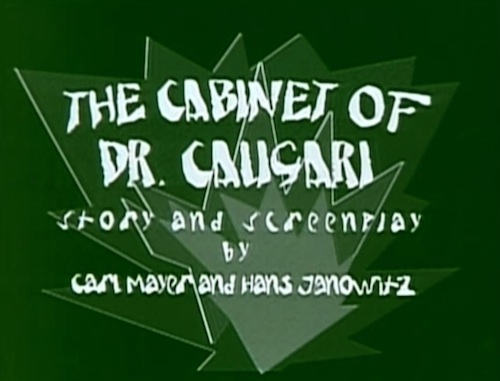
None of this, of course, is essential knowledge for appreciating Robert Weine's The Cabinet of Dr. Caligari—written by Carl Mayer and Hans Janowitz—one of the earliest and most successful of the Ufa films. In fact, I think you can intuit many of the goals and obsessions of German Expressionism just from watching the film, and experiencing its jagged, threatening aesthetic, its violent and psychologically tortured story, its uncertain and uncomfortable relationships to authority and reality. (Or you can just enjoy it as an early, creepy, creative, darkly visionary movie.)
The film opens with a framing sequence: a young man and an older man are sitting in a garden, sharing stories. "There are spirits everywhere, they are all around us," the old man—who looks rather mad—says. "They have driven me from hearth and home—from wife and child." We receive—and will receive—no explanation for this extraordinary claim, because they are interrupted by the arrival of someone who seems to be one of those spirits: an ethereal figure in white who wanders trancelike from the furthest depths of the shot, nearer and nearer, until she moves to the foreground and out of sight. "That is my fiancée," the young man says, and launches into his own story.
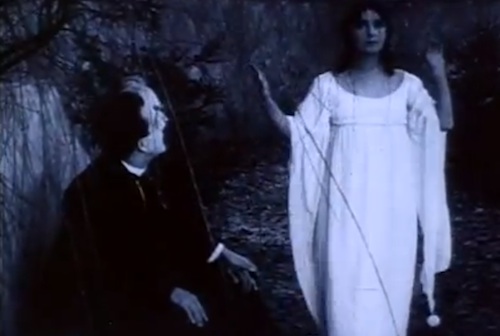
We'll discuss this framing sequence in more depth below, but even knowing now what it means—and why it's there—it's an incredibly effective opening, haunting, unsettling, and unnerving: we are given no bearings, and no answers to the half-dozen questions we are already forming. The effect—and intent—of this sequence is complicated and problematic, as we shall see, but considered as a pure piece of filmmaking it is evocatively frightening and instantly engaging: we are plunged without comfort into a dreamlike world.
One of the things that amazed me on first viewing of The Cabinet of Dr. Caligari is its relatively sophisticated narrative structure, unusual for films of the time: it was one of the first films, for example, to employ flashback, and narratives within narratives. One of Weine's favorite transitions is an iris effect—blackness closing in until the screen is reduced to a tiny circle of focus, and then opening again on another scene—and he employs it brilliantly here: he closes in on the storyteller's face, and then out to show the brighter landscape where the story will take place, and then back in to the storyteller. It is a way to make clear to his viewers that we are now shifting into the world of the young man's story—and for all I know, they had never before been asked to process such a visual narrative leap—but it's also wonderfully evocative: it's as though we are drifting in and out of sleep, in and out of the worlds of reality and nightmare, and we're not quite sure which world is which.
Finally the reality of the story solidifies, and stabilizes, and we get our first good look at a very different vista, and a very different aesthetic. If The Cabinet of Dr. Caligari had nothing else to recommend it—and it has plenty—the incredible expressionistic sets alone would be worth studying. All canvas backdrops—in which even the light and shadows are painted on—they evoke a storybook, a book of fairy tales, but the angles are all harsh and jagged, chaotic and illogical: human figures who move through this landscape are at odds with the world around them, in conflict with the threatening, violently askew reality they inhabit. Fittingly, the first human we see here is our villain, Dr. Caligari (Werner Krauss), a mysterious figure in black clothing and exaggerated, almost monstrous make-up: he enters the otherwise empty town square of Holstenwall up a set of oddly angled steps, as though he is a demon climbing out of Hell.
Next we are introduced to our hero, Francis (Friedrich Fehér)—the young man we met earlier—and his best friend Alan (Hans Heinrich v. Twardowski), who comes to convince Francis to go the town fair. Young and happy students—presumably intellectuals—their rooms are slightly more realistic than what we will see of the outside world, more logical and orderly. But here, too, the angles are odd, and the windows—which look out on the more chaotic external world—are distorted and threatening.
Meanwhile, Caligari is applying for a permit to show his exhibit at the town fair: he must appeal to the Town Clerk, a snobby bureaucrat who treats him badly. (Note the numbers and letters painted on the sets of the Clerk's office, signifying the ineffectual attempts of the official structure—the forces of authority and order—to control the chaos through bureaucracy. Later in the film, the offices of the town policemen show the same symbols.)
The town fair is underway, and we see Caligari hawking his exhibition, which he describes as "Cesare, the Somnambulist!" But a title card informs us that "That night, there occurred the first of a series of mysterious crimes." The Town Clerk is discovered dead, having been murdered while he slept. (In this shot, I love the way the window seems to form a giant knife, pointing directly at the dead man's bed.)
The next day, Alan and Francis attend the fair, and catch Caligari's act, which consists of opening the titular cabinet and awakening Cesare (played by a young Conrad Veidt, familiar to later audiences as Major Strasser in Casablanca). Cesare is a "somnambulist," whom Caligari claims has slept for 23 years. (In Cesare's pale, gothic look—and indeed in twisted aesthetic of the entire film—we can see the roots of every movie Tim Burton has ever made.) Awakened, Caligari says, Cesare has the power to answer any question: he knows all, and can see both the past and the future. Alan rushes foolishly forward and asks Cesare, "How long do I have to live?"
"Till dawn tomorrow!" Cesare proclaims, ominously. Alan and Francis seem momentarily horrified by this proclamation, but they soon move on to more important matters: they are both in love with the same woman, Jane (Lil Dagover). The two young men agree that they will let Jane decide between them, and that they will remain friends no matter what. Even more so than in the average silent film of the time, these relationships are drawn in extraordinarily broad strokes: we really know nothing of who these men are, let alone what Jane may be like, or which of the men she might herself prefer. Those things don't matter: the people are types, not characters, and the love-triangle is archetypal, both mythically universal and instantly relatable.
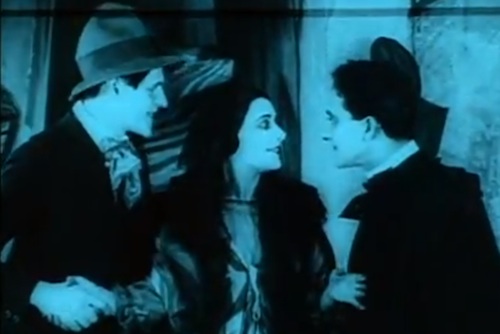
However, this love triangle turns out to be a red herring, one designed simply to ensure we have an emotional investment in what is about to happen. For no sooner is the rivalry established than it is violently resolved: that same night, Alan is—as Cesare predicted—murdered in his bed by a mysterious figure. This is a fantastic sequence, the attack filmed largely in shadowed silhouette, with quick cuts to show Alan's horrified reactions. I don't know if Alfred Hitchcock would have cited this scene from Caligari as an influence on Psycho and its famous shower scene, but if nothing else you can see that Robert Heine knew a thing or two about filming a suspenseful stabbing some forty years earlier.
Francis—in the time-honored tradition of mystery stories—then becomes our hero and amateur sleuth, determined to get to the bottom of the murders: "I won't rest until I have solved these horrible crimes!" he proclaims. But first he must break the news to Jane. The sequence in which he does so is a marvellous example of the art of conversations in silent films: there is not a single intertitle in this sequence, and yet we know exactly what they are saying. We see him tell her that Alan is dead, and her shocked reaction. And then we see her ask him how Alan died, and we know he says that Alan was murdered, provoking a stronger, more horrified reaction. Not a word, spoken or written, is needed.
As a character, Jane is even less distinct than the men: she is simply a figure of pure beauty, a feminine ideal. We can see this in how her home is portrayed: it is the only set in the entire film that has no sharp angles or jagged lines, just soft curves and comforting symmetry. Here we see the Romantic longing that co-exists with the themes of alienation and dehumanization in Expressionism: however harsh and hostile the outside world, whatever chance of happiness there is—and whatever is still good and worth protecting—is here.
Naturally, she is the next to come under attack. Francis has applied Scooby Doo logic to the mystery, and realized that there is only one suspect in the murders: the mysterious Caligari. (Cleverly, however, the film offers us a complication: a third murder is interrupted, and a man is arrested and blamed for the previous crimes: he turns out, however, to be a copycat killer, who had nothing to do with the deaths of the Clerk or Alan.) Francis goes to investigate Caligari; Jane goes searching for Francis at the fair, but misses him, and comes to the attention of Caligari, who tries to lure her inside. That night, Francis stakes out the wagon, where he believes Cesare lies sleeping in his coffin-like cabinet. However, Francis has been duped by a dummy in the cabinet: the real Cesare has gone after Jane. He enters her room with a knife, intent on killing her, but he is overtaken by her beauty and kidnaps her instead.
This is another fabulously staged sequence: Jane's bed is soft, curved, and romantic—like the rest of her home—but the angle of the shot includes the windows, which—again—are harsh lines and sharp angles, bringing in the threat from outside. Cesare enters through these windows, emerging in one shot from the far back of the frame and slowly moving in on her bed with a knife. What really surprises me about this scene, however, is how brutal and primal it is: it looks like monstrous lust on Cesare's face, not love, and their ensuing struggle is violent and sexually charged, more like a rape than anything else.
Cesare flees into the hills, and into some more fantastically chaotic scenery. Early Expressionists tended to view nature more ideally, as a cure for the ills of the modern age, but here—in the years after the war—nature is every bit as harsh and threatening as the urban environments. Jane's father (Rudolf Lettinger)—who was awakened by the struggle—is in hot pursuit, leading a posse of townsfolk. The influence of this scene—and, in fact, of the entire film—can be seen in James Whale's Frankenstein (1931), though Victor Frankenstein's creature had a tender, tragic humanity that Caligari's creature does not have: Cesare is a creature of pure id, a nightmare of the subconscious.
Cesare, exhausted, drops Jane, who is rescued by the townsfolk: Cesare then wanders further into the hills, and—for reasons that are not entirely clear—dies. I've watched this sequence several times, and there's no good explanation for Cesare's death: the best I can come up with is that it is dawn—the next scene switches its tinting from blue to sepia, which is how Weine indicated night and day—and that somehow the rising of the sun dispels Cesare. Symbolically, he is a figure of darkness, a monster risen from Caligari's subconscious, who can not survive exposure to the harsh, waking light of day. (That's just a guess, however.)
Francis and the police confront Caligari, who flees the scene, and the ensuing chase leads them all to the local insane asylum. And finally, the mystery of the figure calling himself "Dr. Caligari" is revealed: he is actually the Director of the asylum, a doctor who has become obsessed with the legend of a medieval figure called Caligari, who used his hypnotic control of a somnambulist to commit murders. Francis and the police discover the Director's journal, and as they read it we flash back to the Director's growing obsession with this legend, his first meeting with the catatonic patient Cesare, and the burgeoning madness that led him to become Caligari. (This is incredibly sophisticated storytelling for the time period: Caligari was one of the first films to employ flashback at all, and—remembering that the entire movie is a story Francis is telling—this is now a flashback within a flashback.)
One of the most striking sequences in the film is the surreal hallucination the mad Director has, in this flashback, of seeing the words Du mußt Caligari werden, which appear in the air all around him: You must become Caligari. (An interesting side-note: among the many things the filmmakers of Caligari invented, long before anyone else thought of it, was viral marketing. Supposedly, the producers had posters with the words "Du mußt Caligari werden" placed all around Berlin, without explanation, to generate curiosity and buzz around the upcoming film.)
With the mystery solved, Francis and Jane are engaged to be married, the Director is safely imprisoned in his own madhouse, and the story ends happily.
Except it doesn't. Because—in proof that we in the modern age did not invent the twist ending—we emerge back in the framing sequence, with Francis telling his story to the old man. The story concluded, they rise from their bench and wander back into the courtyard of the asylum. There, mad men and women wander around babbling: among them is Cesare, leaning against a wall, nearly catatonic, and Jane, sitting regally in a chair, believing she is a queen. We realize that Francis, Jane, and Cesare are all patients in the madhouse, and that Francis has constructed this entire fantasy in which he is the hero, and in which the figure of authority—the Director of the asylum—is the villain.
The Director emerges—without his monstrous makeup, now revealed to be a kindly figure after all—and says that understanding Francis's Caligari delusion gives him the key he needs to finally cure the young man. And so the film achieves a happy ending after all, albeit one of a very different kind.
This framing sequence, which upends the main narrative, was forced on the filmmakers by the studio, which feared that the original story of the murders would prove too dark and disturbing for audiences. Ufa asked director Fritz Lang to come up with an idea to soften Weine's film, and Lang suggested this ending, in which there were no murders, just the delusions of a sick young man.
Apart from this evidence that studio interference is as old as cinema itself, I find the framing sequence fascinating, and I'm not sure it subtracts from the film as much as many critics seem to think. On the one hand, yes, it distorts the intention of the film: instead of a story in which the old establishment figure—the character of the Director—is proven to be corrupt and evil, it becomes a story in which the young (presumably liberal) student is shown to be delusional. Instead of a story in which authority is overthrown, and the old order is questioned, we now have a story in which authority is reinforced, and order is restored.
And yet the studio-imposed framing sequence adds an additional layer of narrative uncertainty that, to me, makes The Cabinet of Dr. Caligari far more interesting than it might otherwise be, and—in a way—far more subversive. One of the things that fascinates me about this is that Ufa believed this ending somehow made the film more palatable: as though audiences would be comforted to learn that our heroes—our romantic leads—were both completely insane, and that everything we had believed to be true was a lie. Perhaps German audiences at the time did find the restoration of order and authority at the end of The Cabinet of Dr. Caligari to be comforting: I find it far more nihilistic and unnerving than the original ending might have been. After all, though the Director says he can now cure Francis, no such promise is made about Jane, so the happy ending—the Romantic ending, the promise of peace and joy that Jane represented—has been destroyed. And where is Alan? The story we have watched becomes even darker if we interpret it through this new ending: Caligari (the evil figure of authority) and Cesare (the monstrous expression of subconscious will) both become creatures of Francis's tormented psyche, who (at least in Francis's mind) murdered his best friend and rival for Jane's affections.
More importantly, even once we understand the "truth" of the story, the main narrative—which we are now told was a delusion—is still so vivid and powerful that it overshadows everything else, and therefore leaves us unsettled and on uncertain ground. For what I suspect was the first time in film history, audiences were being told that they couldn't trust the storyteller, couldn't trust the evidence of their own eyes, and would have to constantly question the "reality" they were watching: this new medium, which seemed to promise such verisimilitude, could be used to completely deceive. Though Lang's ending may undermine the political message Weine, Mayer, and Janowitz intended, this last trick only enriches the unnerving effect of The Cabinet of Dr. Caligari and reinforces its place as one of the most important and influential films of the silent era.
Next on the Syllabus: Next week, we continue our look at German Expressionism—albeit of a slightly different kind—with F. W. Murnau's classic horror film Nosferatu (1922). Then we skip over to Russia for Sergei Eisenstein's 1925 masterpiece Battleship Potemkin, before coming back to Germany for Fritz Lang's Metropolis (1927).
Bibliography
One of the reasons I never went to grad school is that I'm terrible and poorly disciplined about research. However, I do want to acknowledge that I read a number of pieces around the web as I was writing this article, all of which contributed to my shallow understanding of Expressionism and/or the film in one way or another. Below is a list—in no particular order, and probably incomplete—of links to pieces and sites I found useful, though these people should not be held responsible for my own factual errors, misunderstandings, and ill-informed opinions.
http://www.moma.org/explore/collection/ge/index
http://www.trashface.com/germanexpressionism.html
http://hcl.harvard.edu/hfa/films/2010octdec/weimar.html
http://www.screened.com/german-expressionism/27-99/
http://www.allamaiqbal.com/publications/journals/review/apr70/3.htm

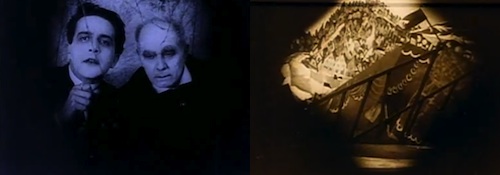
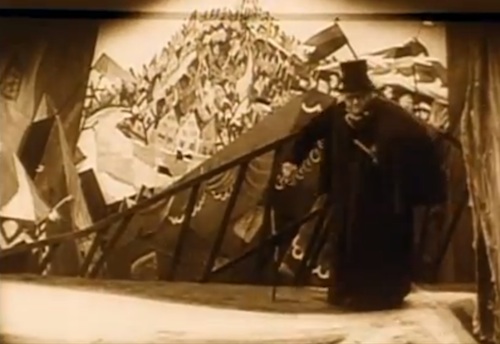
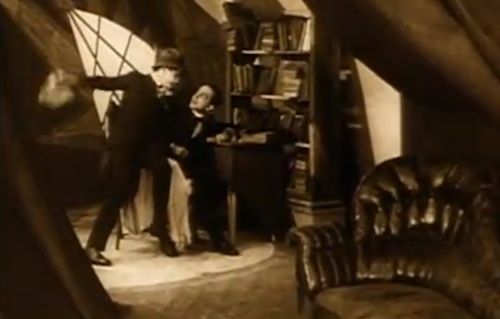
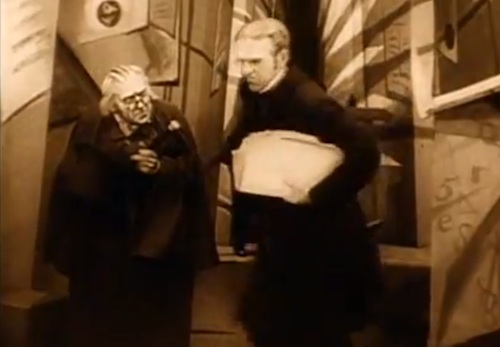
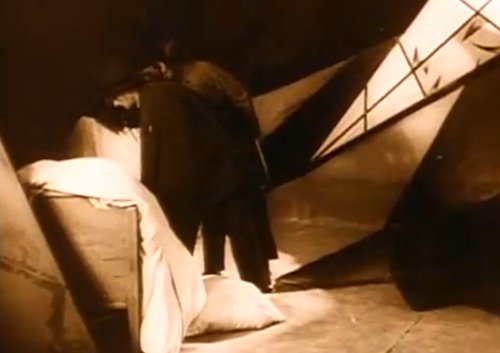
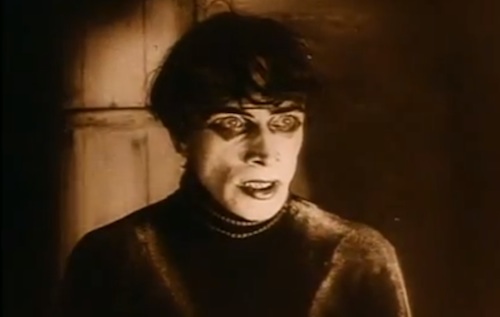


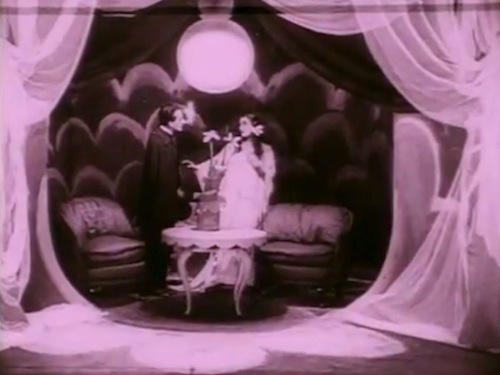
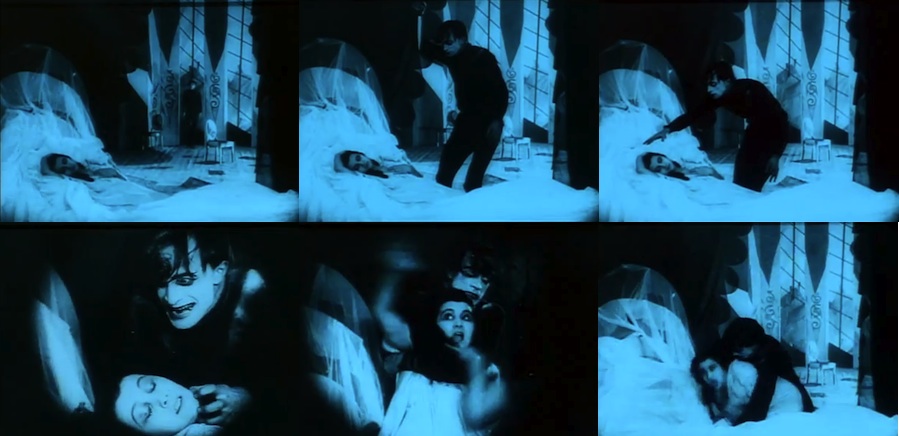
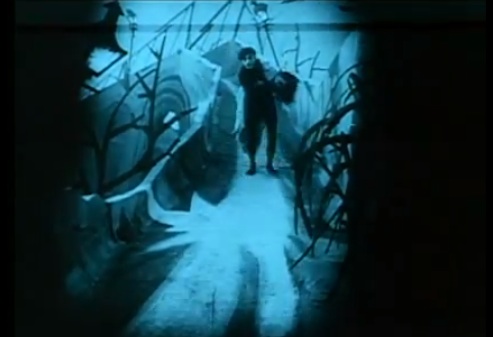
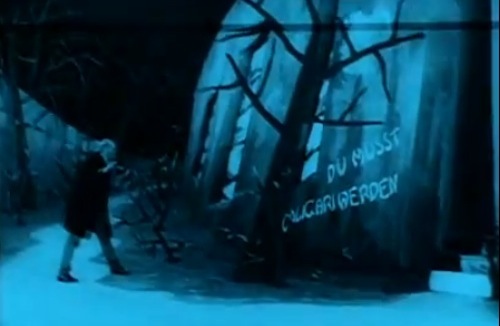
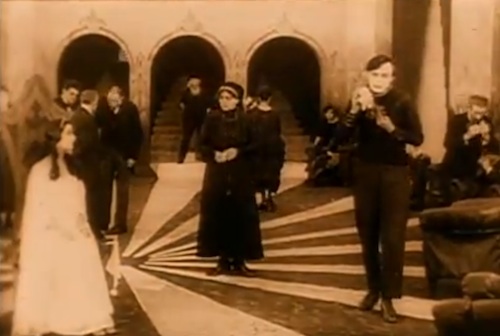
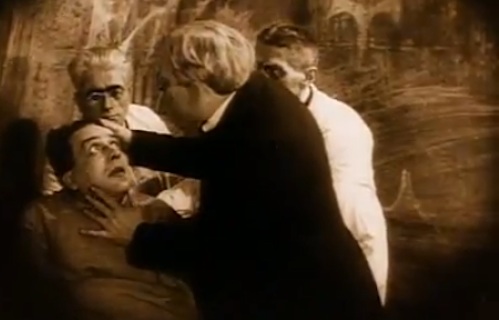
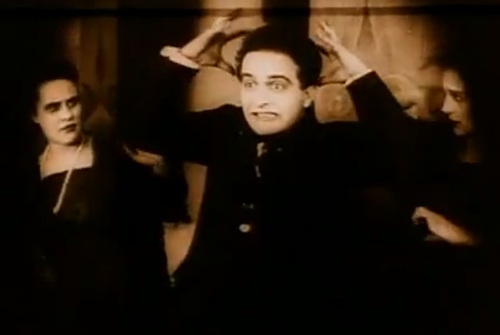

4 thoughts on “THE CABINET OF DR. CALIGARI (1920)”
And my approach to Caligari is even far LESS nuanced…
There isn't much else more scary than a somnabulist. The crazy set pieces ain't CGI, but they also are way more scary.
"Haxen: A History of Witchcraft" (1919?…Swedish?) is probably my favorite silent horror movie. "There are spirits everywhere, they are all around us…" good opener.
I wasn't familiar with Häxan, Dan, but it looks awesome: I'll have to check it out. Thanks for the recommendation.
Great idea. I'll follow along when I can!
Second on Haxan. It only started poking its way into film histories when Criterion re-released it in 2001, but it really deserves to be better known.